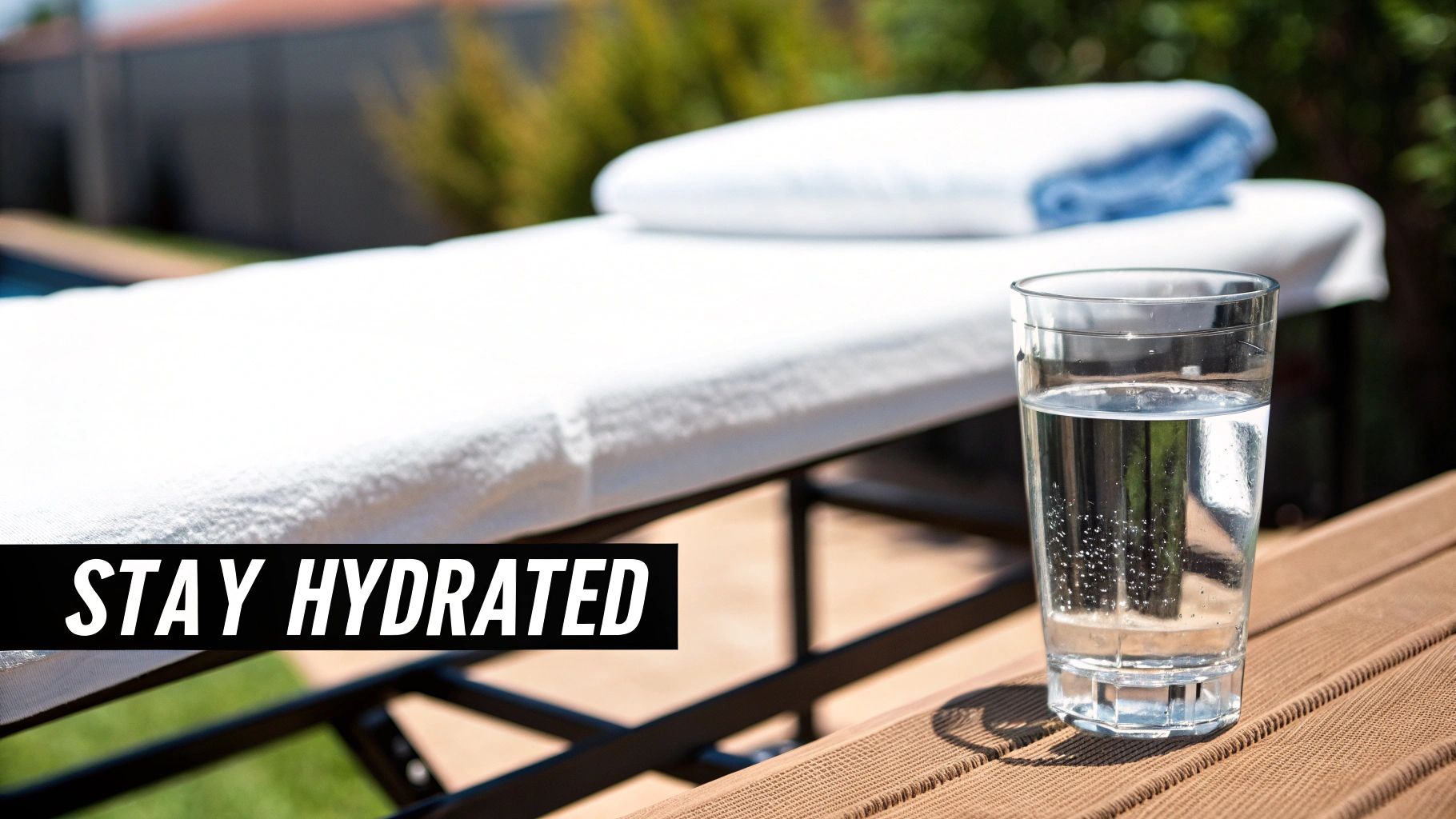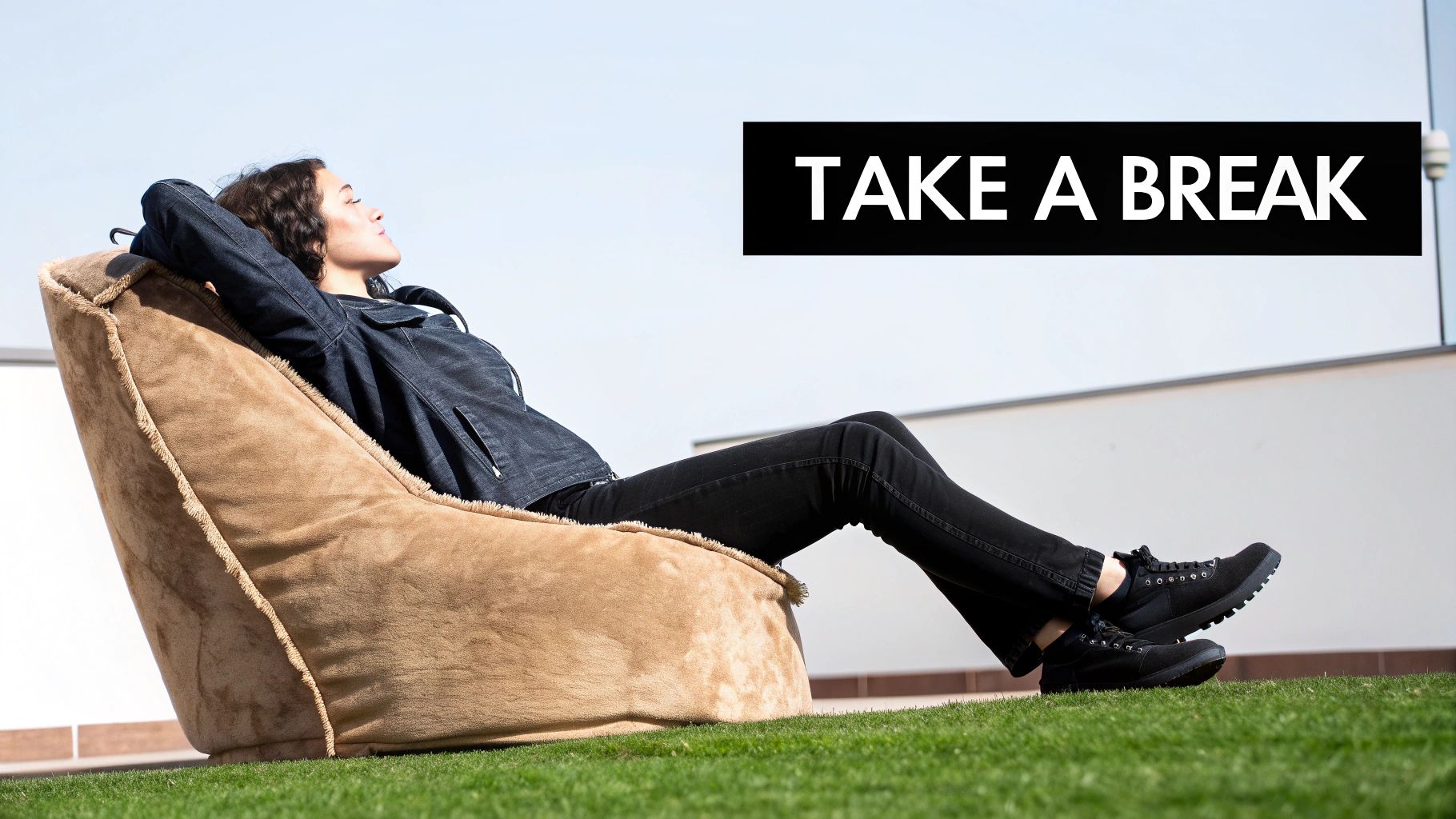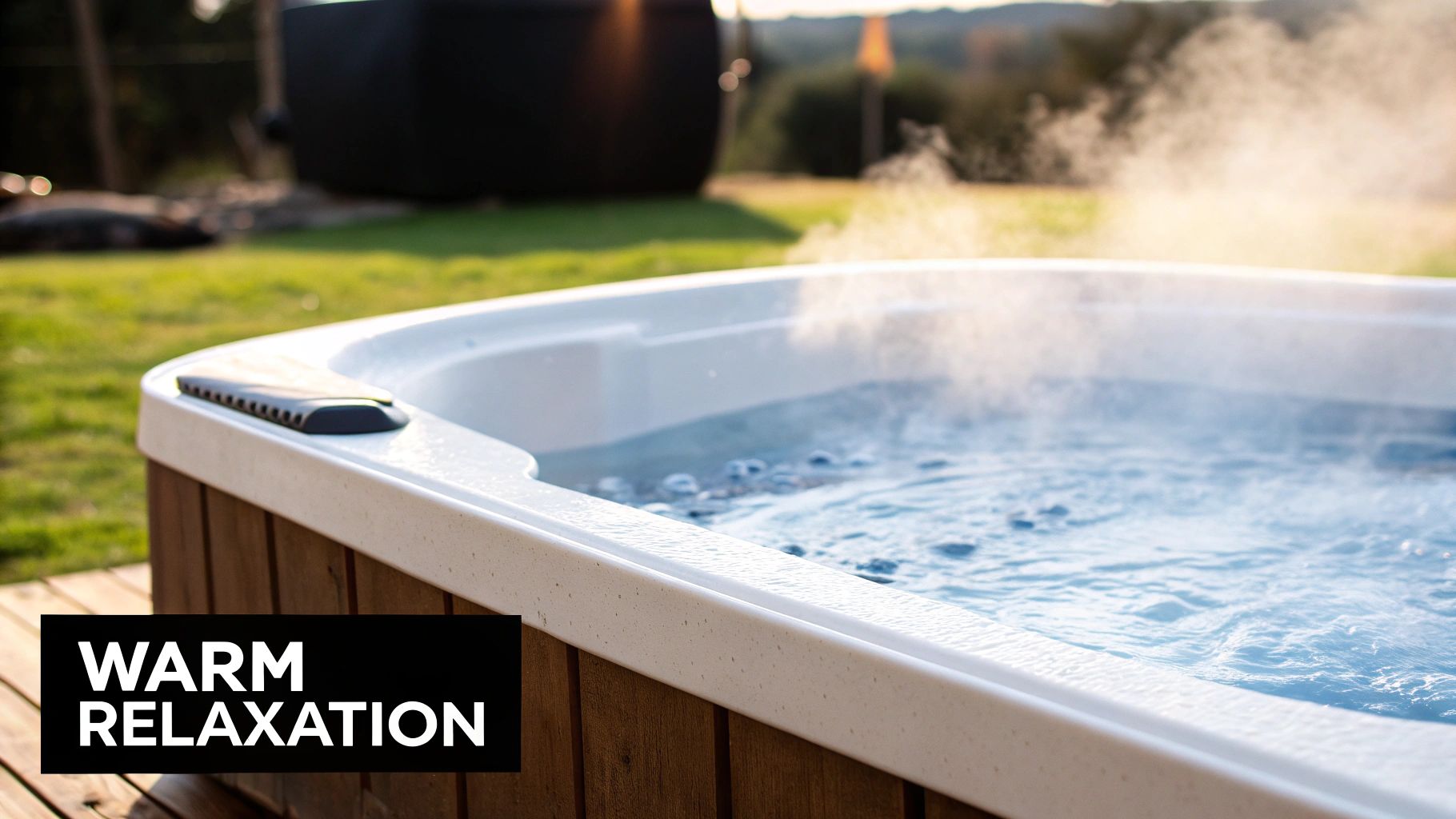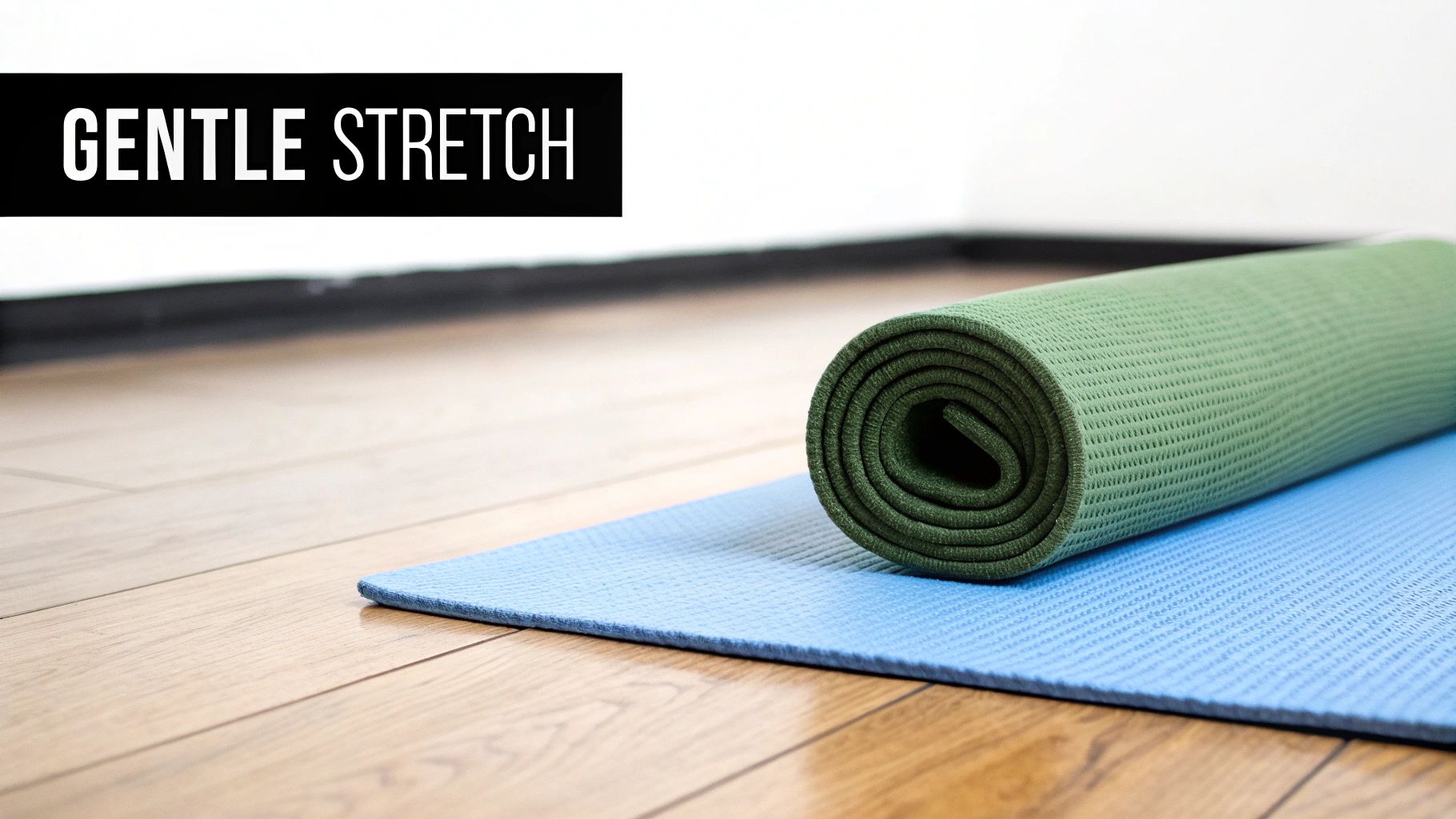You've just stepped out of a blissful massage session, feeling relaxed and rejuvenated. But the benefits don't have to end when you leave the spa. The 24 hours following your appointment are a critical window for maximizing therapeutic effects and ensuring long-lasting relief. Proper post massage care is the secret to transforming a great massage into an exceptional wellness experience, a concept that complements other physical wellness routines. For athletes and fitness enthusiasts, this practice is as vital as understanding smarter post-workout recovery strategies for peak performance.
Effective aftercare involves a series of simple, intentional actions that support your body's recovery process. These steps help flush out metabolic waste released from your tissues and lock in that profound sense of calm and flexibility. Neglecting this crucial phase can unfortunately lead to next-day soreness, dehydration, and a quick return of the very tension you just paid to release.
This guide provides six essential, actionable strategies to extend the benefits of your treatment. Whether you've had a soothing Swedish massage or an intense deep tissue session, these expert-approved tips will help you make the most of your investment in your well-being and prolong the positive effects for days to come.
1. Hydrate Immediately and Continuously
Of all the post massage care steps you can take, rehydrating your body is arguably the most critical. Think of a deep tissue massage as a form of passive exercise for your muscles. The therapist's hands, elbows, and tools work to release tight knots and adhesions, which stimulates circulation and encourages the release of metabolic waste products stored in your tissues. Proper hydration is the vehicle that flushes these byproducts out of your system, preventing them from lingering and causing post-massage soreness or fatigue.
Without sufficient water, your body cannot efficiently process and eliminate these substances. The increased blood flow and lymphatic drainage initiated by the massage require fluid to function optimally. Failing to hydrate is like cleaning your house but leaving the trash bags inside; the system gets bogged down, and you won't feel the full, rejuvenating effects of your session. This simple step is fundamental to maximizing your recovery and prolonging the benefits of the therapy.

Why It Works and When to Do It
Hydration supports the kidneys and lymphatic system, the body's primary filtration and waste removal powerhouses. After a massage, especially an intense session for athletic recovery or chronic pain, these systems are working overtime. Providing them with ample water ensures they can transport and expel waste effectively, reducing inflammation and muscle ache.
This principle is so vital that it's a standard protocol in professional settings. Leading organizations like the American Massage Therapy Association (AMTA) emphasize its importance for client recovery. You will often see athletic recovery centers providing electrolyte-enhanced water after deep tissue work or medical massage clinics tracking patient hydration as part of a comprehensive treatment plan. The goal is to support the body’s natural detoxification process immediately when it's most active.
Actionable Hydration Tips
To make the most of your post massage care, apply these specific hydration strategies:
- Immediate Intake: Drink a large glass of water, about 16-20 ounces, within the first 30 minutes after your massage ends. This kickstarts the flushing process immediately.
- Sustained Hydration: Don't stop after the first glass. Continue to sip water steadily throughout the rest of the day to support your system over several hours.
- Add Electrolytes for Intensity: If you had a particularly deep or intense massage, such as sports massage, consider adding an electrolyte powder or tablet to your water. This helps replenish essential minerals like sodium and potassium lost through metabolic processes, which can prevent dehydration headaches.
- Monitor Your Progress: A simple way to check your hydration level is to monitor your urine color. Aim for a pale, straw-like yellow, which indicates you are well-hydrated.
2. Rest and Allow Recovery Time
Jumping back into a strenuous routine immediately after a massage can counteract its therapeutic effects. Effective post massage care requires you to give your body and nervous system a dedicated period to rest and integrate the work that was done. Think of it as allowing a complex machine to recalibrate after a major tune-up. Your muscles have been stretched and manipulated, and your nervous system has shifted from a state of stress to one of relaxation. Rest is the crucial final step that solidifies these positive changes.
This period of quiet allows your body to fully process the physiological shifts initiated by the massage, from improved circulation to the calming of sensory receptors. Without this downtime, you risk overstimulating your muscles and nervous system, which can lead to increased soreness or even re-tightening the very muscles you just paid to have released. Giving yourself permission to be still is not an indulgence; it's an essential component of maximizing the therapeutic investment you made in your health.

Why It Works and When to Do It
Resting after a massage allows your parasympathetic nervous system, often called the "rest and digest" system, to remain dominant. This state is optimal for muscle recovery, tissue repair, and reducing inflammation. When you immediately engage in stressful or physically demanding activities, you trigger the "fight or flight" sympathetic nervous system, which can halt the recovery process and negate the massage's benefits.
This principle is widely endorsed by professionals. For instance, the International Association of Healthcare Practitioners emphasizes rest for somatic integration, while sports massage therapists universally include it in recovery protocols. Day spas often institutionalize this by creating relaxation rooms for post-treatment rest, and medical massage clinics may advise patients to modify work duties on the day of their session. The goal is to extend the state of deep relaxation for as long as possible to ensure the body absorbs the full benefits. For a deeper dive into recovery protocols, you can find valuable insights on muscle recovery tips at LaMoonDaySpa.com.
Actionable Rest and Recovery Tips
To properly incorporate rest into your post massage care routine, use these targeted strategies:
- Plan Ahead: Schedule your massage on a day with a light schedule or at a time when you have at least 2-4 hours of downtime afterward.
- Avoid Intense Activity: Refrain from strenuous exercise, heavy lifting, or high-stress situations for at least 12-24 hours. This gives your muscles time to recover without being strained.
- Embrace Gentle Movement: If you feel the need to move, opt for gentle, restorative activities. A slow walk, light stretching, or a mindful yoga session can complement the massage without overtaxing your body.
- Create a Calm Environment: Use your rest period to engage in calming activities. Listen to soothing music, meditate, read a book, or simply lie down in a quiet, comfortable space to let your body and mind unwind completely.
3. Take a Warm Bath or Shower
Extending the therapeutic benefits of your massage is a key part of effective post massage care, and a warm bath or shower is one of the most pleasant ways to do it. The gentle heat of the water helps to maintain the increased circulation stimulated during your session, which is vital for delivering oxygen and nutrients to your recently worked muscles. This continued blood flow helps to soothe any potential next-day soreness and deepens the state of relaxation you achieved on the massage table.
A warm soak acts as a gentle continuation of the therapy, allowing your muscles to remain pliable and relaxed rather than quickly tensing up again. This practice is rooted in hydrotherapy principles and is a staple in wellness cultures worldwide, from European spas to Japanese onsen traditions. It’s a simple yet powerful step to bridge the gap between your session and your return to daily activities, ensuring the benefits last as long as possible.

Why It Works and When to Do It
The primary mechanism behind a post-massage bath is heat's ability to promote vasodilation, or the widening of blood vessels. This effect complements the massage by keeping the circulatory and lymphatic systems active, aiding in the removal of metabolic byproducts that can cause muscle stiffness. For athletes or those with chronic aches, this can be particularly beneficial for reducing inflammation and accelerating recovery.
However, timing is crucial. It is generally recommended to wait at least two to four hours after your massage before bathing. This allows your body time to process the initial physiological changes from the session. It also gives any therapeutic oils or lotions used during the treatment time to fully absorb into your skin; many of which have their own anti-inflammatory and relaxing properties. For a deeper understanding of how different oils contribute to this process, you can learn more about massage oils for relaxation.
Actionable Bathing Tips
To turn your bath or shower into a therapeutic extension of your massage, follow these specific strategies:
- Wait for the Right Time: Allow a minimum of two hours to pass after your session before stepping into the tub or shower to maximize the benefits of any applied products.
- Mind the Temperature: Keep the water warm, not hot. The ideal temperature range is between 98-102°F (36-39°C). Water that is too hot can be dehydrating and may cause lightheadedness.
- Enhance with Epsom Salts: Add one to two cups of Epsom salt (magnesium sulfate) to your bath. Magnesium is a natural muscle relaxant that can be absorbed through the skin, helping to further ease soreness and tension.
- Keep it Brief: Limit your soak to 15-20 minutes. Prolonged exposure to warm water can start to strip your skin of natural oils and lead to dehydration.
- Stay Hydrated: Just like after the massage itself, drink a glass of water before and after your bath to stay properly hydrated.
4. Eat Light and Nutritious Foods
After a massage, your body's energy is channeled toward processing the therapeutic work done on your muscles and tissues. Consuming a heavy, greasy, or highly processed meal forces your digestive system to work overtime, diverting that crucial energy away from recovery. Proper post massage care involves choosing foods that support your body's healing state, not burden it.
Light, nutrient-dense foods provide the building blocks for muscle repair without causing digestive stress or sluggishness. Think of it as providing clean fuel for a finely tuned engine. Just as you wouldn't put low-grade fuel in a high-performance car after a tune-up, you shouldn't weigh your body down with difficult-to-digest food after a massage. This nutritional strategy helps you feel light and energized, enhancing the restorative effects of your session.

Why It Works and When to Do It
Your circulatory and lymphatic systems are highly active after a massage, working to clear metabolic byproducts. Heavy foods require significant blood flow to the digestive tract, pulling it away from the muscles and tissues that need it for recovery. Light, easily digestible meals allow your body to continue focusing its resources on repairing muscle tissue, reducing inflammation, and flushing out waste.
This principle is widely endorsed by integrative medicine practitioners and wellness nutrition experts. Many high-end spas and wellness retreats curate specific post-treatment menus featuring light salads, brothy soups, and lean proteins for this exact reason. The goal is to complement the physical therapy with nutritional support, creating a holistic recovery experience and ensuring clients leave feeling rejuvenated, not bloated or lethargic. This is a key component of a comprehensive post massage care plan.
Actionable Nutrition Tips
To properly fuel your recovery without overloading your system, apply these post-massage eating strategies:
- Wait Before You Eat: Give your body 60-90 minutes after your session before having a meal. This allows your system to begin its rebalancing process without the immediate demand of digestion.
- Focus on Anti-Inflammatory Foods: Actively support your body's healing by choosing foods known to reduce inflammation. Excellent choices include berries, leafy greens like spinach and kale, turmeric, ginger, and healthy fats from avocado or nuts.
- Prioritize Lean Protein and Veggies: A small portion of grilled chicken, fish, or tofu paired with steamed or raw vegetables provides essential amino acids for muscle repair and vitamins for overall function. A simple salad or a light soup is an ideal choice.
- Avoid Heavy or Processed Items: Steer clear of fried foods, red meat, refined sugars, and excessive dairy immediately following your massage. These foods can promote inflammation and make you feel sluggish, counteracting the benefits of your treatment.
5. Gentle Movement and Stretching
While it may be tempting to remain completely still after a massage, incorporating light movement and stretching is a vital step in your post massage care routine. A massage works to lengthen and relax muscle fibers, increasing your range of motion and flexibility. Gentle movement helps your body acclimate to this newfound freedom, preventing the muscles from tightening up again and causing stiffness. It essentially helps "lock in" the benefits of the session.
This approach encourages continued circulation, delivering oxygen-rich blood to the tissues that were just worked on. It also supports the lymphatic system in clearing out any residual metabolic waste released during the therapy. Think of it as gently reminding your muscles of their new, more relaxed state. This proactive step helps you integrate the therapeutic work, ensuring the suppleness and relief you feel on the table lasts for days, not just hours.
Why It Works and When to Do It
Gentle movement prevents the body from reverting to its old patterns of tension. Physical therapists and sports medicine professionals often prescribe specific stretches and light exercises after manual therapy to re-educate the neuromuscular system. By actively moving through a greater range of motion, you reinforce the positive changes achieved during the massage, which is especially important for addressing chronic pain or stubborn muscle knots. For an even deeper understanding of this process, you can find more information about releasing persistent tension in our detailed guide on how to get rid of muscle knots.
This practice is so effective that many wellness centers and yoga studios now offer post-massage gentle movement classes. The ideal time to start is within a few hours of your session, once you've had some time to hydrate and rest. The goal is not to perform a strenuous workout but to move with intention, focusing on fluidity and ease to prevent soreness and maintain flexibility.
Actionable Movement Tips
To properly integrate movement into your post massage care, follow these specific strategies:
- Start with a Walk: Engage in a slow, gentle walk for 10-15 minutes later in the day. This is a simple, low-impact way to encourage full-body circulation.
- Target Key Areas: Perform light, static stretches for the areas that received the most focus during your massage. If your therapist worked on your shoulders, do gentle shoulder rolls and cross-body arm stretches.
- Hold, Don't Bounce: Hold each stretch for 15-30 seconds without bouncing. This allows the muscle fibers to relax and lengthen safely.
- Listen to Your Body: The guiding principle is to avoid pain. The movement should feel good and restorative. If you feel any sharp or significant discomfort, stop immediately. Your body has just undergone therapy, so be gentle with it.
6. Avoid Alcohol and Stimulants
While it might seem tempting to follow a relaxing massage with a celebratory glass of wine or a cup of coffee to re-energize, this is one of the most counterproductive things you can do for your post massage care. Alcohol and stimulants like caffeine directly oppose the therapeutic goals of your session. A massage is designed to hydrate tissues, calm the nervous system, and flush out metabolic waste; alcohol and caffeine are diuretics that dehydrate the body and stimulants that can re-introduce tension.
Consuming these substances essentially asks your body to do two conflicting things at once. Your system is working hard to process the effects of the massage and enter a state of deep recovery, but alcohol and caffeine force it to metabolize toxins and elevate your heart rate. This interference can negate the benefits you just invested in, leading to dehydration, increased soreness, and a disrupted sense of calm. Steering clear of them is crucial for allowing the body to fully absorb the positive effects of the therapy.
Why It Works and When to Do It
Alcohol is a diuretic that can severely dehydrate you, directly undermining the hydration efforts that are so critical after a massage. It also acts as a depressant on the central nervous system, which may initially feel relaxing but ultimately interferes with the body's natural healing rhythm. Caffeine, a powerful stimulant, can cause muscles to tense up and may increase feelings of jitteriness, undoing the deep relaxation you achieved on the table.
This advice is a standard protocol across the wellness industry. Most reputable spas and medical massage clinics have policies advising clients to avoid alcohol post-treatment. For instance, wellness centers focused on detoxification or holistic health often provide educational materials explaining how these substances disrupt the body's equilibrium. Avoiding them immediately after your session allows your body to remain in a parasympathetic (rest and digest) state, which is optimal for tissue repair and recovery.
Actionable Avoidance Tips
To ensure your massage benefits are fully realized, incorporate these specific strategies:
- Set a 24-Hour Rule: Forgo alcoholic beverages for at least 24 hours after your massage. This gives your liver and kidneys ample time to process metabolic waste from your muscles without the added burden of metabolizing alcohol.
- Limit Caffeine for the Day: Avoid coffee, caffeinated sodas, and energy drinks for the remainder of the day. This prevents overstimulation of the nervous system and helps you maintain a relaxed state.
- Opt for Calming Alternatives: If you crave a warm beverage, choose decaffeinated herbal teas like chamomile, peppermint, or ginger. These can aid digestion and enhance relaxation, complementing the effects of your massage.
- Plan Your Sessions Strategically: If you know you have a social event involving alcohol, schedule your massage for a different day. Planning ahead ensures you won't have to choose between your recovery and your social life.
Post-Massage Care: 6 Key Practices Compared
| Post-Massage Care | Implementation Complexity 🔄 | Resource Requirements ⚡ | Expected Outcomes 📊 | Ideal Use Cases 💡 | Key Advantages ⭐ |
|---|---|---|---|---|---|
| Hydrate Immediately and Continuously | Low – simple habit change | Minimal – water or electrolyte drinks | Supports detox, prevents headaches, maintains tissue elasticity | All massage clients, athletes, recovery settings | Simple, immediate effects, enhances massage benefits |
| Rest and Allow Recovery Time | Moderate – requires scheduling and time | Low – quiet space or relaxation area | Nervous system integration, muscle recovery, stress regulation | Clients with flexible schedules, sports massage, medical massage | Maximizes benefits, supports natural healing |
| Take a Warm Bath or Shower | Low – easy home/self-care activity | Low – access to bath/shower | Continued relaxation, circulation, soreness management | Home care, spa environments, wellness routines | Extends massage benefits, accessible and relaxing |
| Eat Light and Nutritious Foods | Moderate – requires meal planning | Moderate – nutritious food | Supports energy restoration, tissue repair, digestive comfort | Wellness-focused clients, retreats, nutrition plans | Supports recovery, maintains energy, prevents discomfort |
| Gentle Movement and Stretching | Moderate – needs technique knowledge | Minimal – space for light activity | Maintains flexibility, circulation, prevents stiffness | Yoga, PT clinics, active individuals | Extends benefits, improves range of motion |
| Avoid Alcohol and Stimulants | Low to Moderate – lifestyle adjustment | None | Preserves relaxation, prevents dehydration, supports healing | All clients, especially regular consumers of alcohol/caffeine | Maximizes effectiveness, supports detox and relaxation |
Integrating Post-Massage Care into Your Wellness Routine
The time you spend on the massage table is a powerful investment in your physical and mental well-being. However, the true value of that investment is realized in the hours and days that follow. Treating your post-massage period with intention is the key to transforming a temporary relief into a lasting state of recovery and balance. By embracing a structured approach to your aftercare, you are not just passively receiving benefits; you are actively participating in and amplifying your body's healing process.
From Checklist to Ritual
We've explored six foundational pillars of effective post massage care: immediate hydration, dedicated rest, gentle warming with a bath or shower, light nutrition, mindful movement, and avoiding taxing substances like alcohol. While each of these actions is simple on its own, their collective power is immense. Think of them less as a checklist of chores and more as a cohesive ritual that honors the work your body and your therapist have just accomplished.
- Hydration flushes out metabolic waste released from your muscles.
- Rest gives your nervous system time to recalibrate and your tissues time to repair.
- Nourishment provides the essential building blocks for cellular recovery without overburdening your digestive system.
- Gentle Movement prevents stiffness and encourages healthy circulation, delivering oxygen-rich blood to worked muscles.
Mastering this sequence ensures that the benefits of your session, from decreased soreness to enhanced flexibility and mental clarity, extend far beyond the massage room.
A Holistic Approach to Recovery
Integrating effective aftercare into your routine is about adopting a more holistic view of wellness. It's understanding that what you do after the main event is just as critical as the event itself. This principle extends beyond massage. For instance, just as you carefully choose what to put in your body after a massage, exploring other natural wellness practices can further enhance your results. To further support your well-being, exploring how other natural elements can be integrated into your routine can be beneficial; consider resources like those discussing the unexpected uses for olive oil, including skincare applications, which can complement your recovery process.
Ultimately, your commitment to post massage care elevates a massage from a simple luxury to a cornerstone of your health strategy. It’s a profound act of self-respect that tells your body you are listening to its needs. By planning for this recovery time, you ensure every session delivers maximum, long-lasting impact, helping you feel stronger, more mobile, and deeply restored.
Ready to experience the profound benefits of a professional massage and put your new aftercare knowledge to the test? The expert therapists at La Moon Massage and Facial are dedicated to creating a personalized session that addresses your unique needs. Book your next appointment at La Moon Massage and Facial and take the first step toward integrating expert bodywork and mindful recovery into your life.
